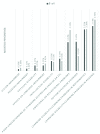Autism spectrum disorder: updated prevalence and comparison of two birth cohorts in a nationally representative Australian sample
- PMID: 28490562
- PMCID: PMC5623420
- DOI: 10.1136/bmjopen-2016-015549
Autism spectrum disorder: updated prevalence and comparison of two birth cohorts in a nationally representative Australian sample
Abstract
Objectives: This study aimed to (1) provide an update on the prevalence of parent-reported autism spectrum disorder (ASD) diagnosis and new information about teacher-reported ASD in two nationally representative Australian cohorts at ages 10-11 years, (2) examine differences in cohort demographic and clinical profiles and (3) compare the prevalence of teacher-reported ASD and any changes in categorisation over time across the cohorts.
Design: Secondary analyses were undertaken using data from the Longitudinal Study of Australian Children (LSAC).
Participants: Children were recruited at kindergarten age (K cohort; birth year 1999/2000) and birth (B cohort; birth year 2003/2004), with follow-up of every 2 years for six waves.
Primary outcome measures: Parent-reported and teacher-reported ASD diagnosis was ascertained at three time points (waves 4-6).
Results: At age 10-11 years, the adjusted prevalence of parent-reported ASD diagnosis was 3.9% (95% CI 3.2 to 4.5) and 2.4% (95% CI 1.6 to 2.9) in the B and K cohorts, respectively. Teacher-reported prevalence of ASD was 1.7% (95% CI 1.2 to 2.1) in the B cohort and 0.9% (95% CI 0.56 to 1.14) in the K cohort. Parents reported fewer conduct and peer problems and teachers more pro-social behaviour in B relative to K cohort ASD children. Children reported only by parents in the later-born B cohort had milder behaviour problems than parent-agreed and teacher-agreed cases. Although individual switching to ASD from other categories from 8-9 to 10-11 years was low (K cohort n=5, B cohort n=6), teachers reported more children with ASD in the B than K cohort at 10-11 years and fewer children with emotional/ behavioural problems.
Conclusions: The higher prevalence of parent-reported and teacher-reported ASD diagnosis in the later-born cohort may be partially explained by identifying children with milder behavioural problems as ASD and a change in the use of diagnostic categories in schools.
Keywords: Autism Spectrum Disorder; epidemiology; prevalence.
© Article author(s) (or their employer(s) unless otherwise stated in the text of the article) 2017. All rights reserved. No commercial use is permitted unless otherwise expressly granted.
Conflict of interest statement
Competing interests: None declared.
Figures



References
-
- Diagnostic and statistical manual of mental disorders (DSM-5). Washington DC: American Psychiatric Publications, 2013. - PubMed
-
- Zablotsky B, Black LI, Maenner MJ, et al. . Estimated prevalence of autism and other developmental disabilities following questionnaire changes in the 2014 National Health Interview Survey. Natl Health Stat Report 2015;87:1–21. - PubMed
-
- Waugh I. The prevalence of autism (including Asperger Syndrome) in school age children in Northern Ireland Health do Belfast, Northen Ireland: Northern Ireland Statistics & Research Agency, 2016.
Publication types
MeSH terms
LinkOut - more resources
Full Text Sources
Other Literature Sources
Medical
